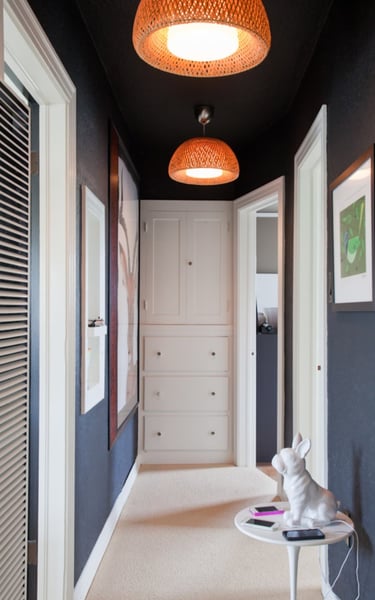How to Choose Interior Paint Colors to Make Small Spaces Feel Larger in Your Colorado Springs Home
Blog post description.
Jared Nappi (Owner/Operator)
11/8/20244 min read


In Colorado Springs, where homes often feature cozy rooms and unique layouts, making small spaces feel more open and inviting can be a challenge. The right paint color can visually expand a room, creating the illusion of more space and adding a brighter, airier feel. Here are some top tips on selecting paint colors to make the most of your smaller spaces.
1. Opt for Light and Bright Neutrals
Lighter colors reflect more light, helping rooms feel larger and more open. Shades like soft white, such as Sherwin Williams Alabaster, light gray, such as Benjamin Moore Stonington Gray, or pale beige, such as Benjamin Moore Carrington Beige, are perfect for creating a spacious atmosphere. These colors are versatile, blend well with a variety of decor styles, and enhance the natural light found in many Colorado Springs homes.
Tip: Pair light walls with similarly light-colored furniture to create a cohesive and expansive look.
2. Choose Cool Tones for a Breezy, Open Feel
Cool tones like soft blue, such as Benjamin Moore Marlboro Blue, a pale green, such as Benjamin Moore Southfield Green, and light lavender, such as Benjamin Moore Lavender Mist, can help a room feel airy and calm, drawing the eye outward and giving a sense of space. Cool colors recede visually, which makes them a great choice for smaller rooms or spaces without much natural light.
Tip: Light blue and green tones work particularly well in bedrooms and bathrooms, adding a touch of relaxation to the space.
3. Use Monochromatic Color Schemes
A monochromatic color scheme, where walls, trim, and decor are all in variations of the same color, can prevent visual clutter and create a streamlined look. By using different shades of the same color, you’ll add depth without dividing the space, which can help a small room appear more open.
Tip: For a classic look, try shades of gray or taupe throughout the room, using slightly different shades on walls, trim, and accents.
4. Embrace Soft Pastels for a Subtle Pop
Pastels like blush pink, soft peach, or mint green add a touch of color without overwhelming a small space. These gentle hues can make a room feel open and fresh while providing a bit of personality. Pastels are ideal for rooms like nurseries, home offices, or even small kitchens.
Tip: Keep furniture and decor neutral to let pastel walls shine or add small pops of color for a harmonious look.
5. Try Two-Tone Walls for Added Depth
Painting the upper half of a wall in one color and the lower half in another can add dimension and interest to a small space. This technique, often used with wainscoting or chair rails, can make walls appear taller and rooms feel larger. Consider a light color on top and a slightly darker hue below for a balanced effect.
Tip: Choose neutral or light colors that complement each other to avoid making the space feel closed in.
6. Use Accent Walls to Draw the Eye Outward
Accent walls are a great way to add character without overwhelming the entire space. By painting one wall a slightly darker shade, you can create depth and draw the eye outward. In small rooms, avoid going too dark—try a shade like dusty blue or soft green that adds contrast without feeling heavy.
Tip: Position the accent wall across from the main entry to make the room feel larger as you walk in.
7. Go for Gloss or Satin Finishes to Reflect Light
Glossy or satin finishes reflect light, adding brightness to the room and making it feel larger. While matte finishes are typically best for hiding imperfections, glossier finishes can enhance the sense of openness. Try satin on walls and semi-gloss on trim to help bounce light around the room.
Tip: Use a satin finish on walls in living rooms or kitchens, where you want a brighter look but don’t need a high-gloss shine.
8. Paint Ceilings a Lighter Shade for Vertical Space
A lighter ceiling can give the illusion of height, making rooms feel taller and more spacious. For rooms with low ceilings, painting the ceiling the same color as the walls (but in a lighter shade) can help blend the boundaries and create a seamless, expansive look.
Tip: White is a classic ceiling color, but if you’re using a light neutral on the walls, consider matching the ceiling for added height.
9. Incorporate White or Light-Colored Trim for Definition
Painting trim white or in a light, neutral shade provides a clean frame around the walls, making them feel larger. This contrast between the walls and trim adds definition and brightens the space without requiring a lot of color.
Tip: If your walls are a soft color, use a bright white trim for a crisp look that enhances the room’s structure.
10. Avoid Dark Colors in Very Small Spaces
Dark colors can make rooms feel cozy and intimate, but in very small spaces, they may feel a bit too confining. If you’re looking to make a small room feel bigger, stick to lighter shades that open up the room. Dark colors can work well as accents but use them sparingly.
Tip: If you love dark colors, consider using them in larger rooms or as accent walls instead of covering the entire space.
Conclusion:
By choosing the right colors and finishes, you can make any small space in your Colorado Springs home feel larger and more inviting. Light neutrals, soft pastels, and strategic color placement are all great ways to add openness without sacrificing style. With these color ideas, you’ll be able to create a bright, welcoming atmosphere that enhances every room’s potential.


Areas We Service
Colorado Springs, Monument, Larkspur, Castle Rock, Parker, Castle Pines, Centennial, Lone Tree & the Denver Metropolitan Area
